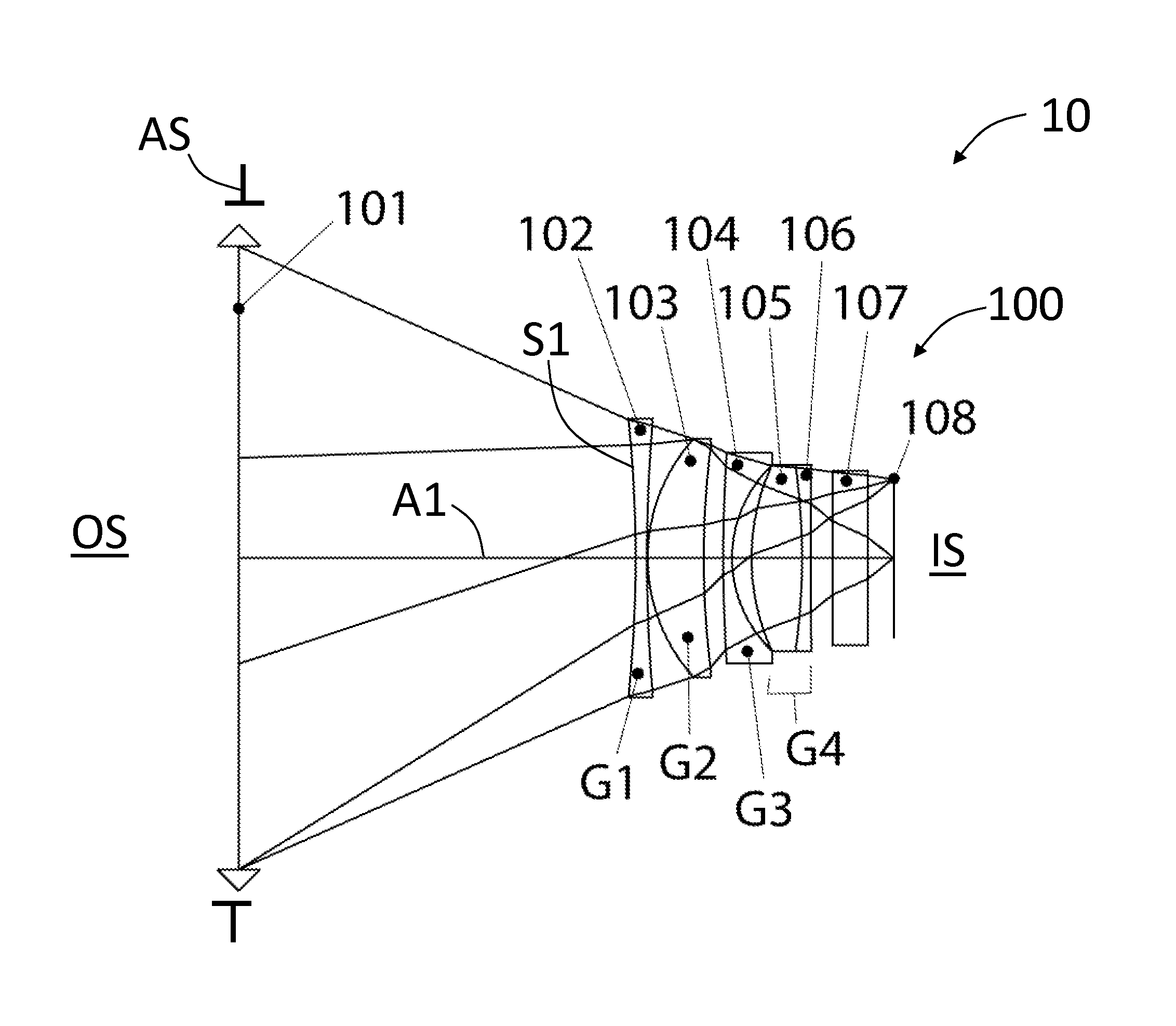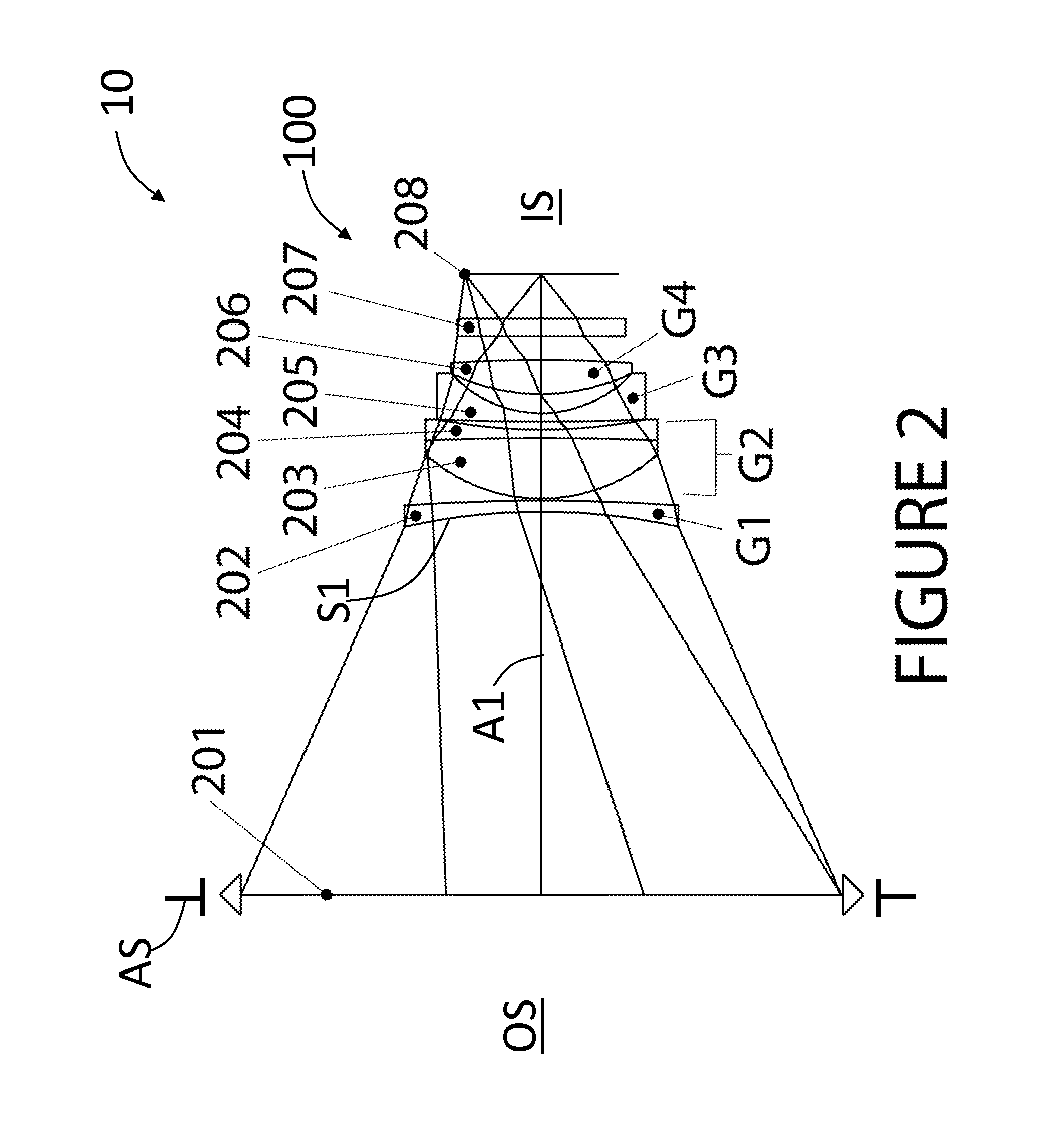Optical attachment for reducing the focal length of an objective lens
- Summary
- Abstract
- Description
- Claims
- Application Information
AI Technical Summary
Benefits of technology
Problems solved by technology
Method used
Image
Examples
example 1
[0040]FIG. 1 is a layout of Example 1 of the present disclosure, which is an example focal-reducing attachment (“attachment”) 100 having an axis A1, an aperture stop AS, an object side OS, and an image plane 108 that defines an image side IS. The example attachment 100 has a focal length f of 65.8 mm and a magnification M of 0.64×. In order to evaluate optical performance, an objective lens 101 is included. For modeling purposes, the objective lens 101 is treated paraxially and in Example 1 has a focal length of 80 mm, with the objective lens 101 being placed 45.3 mm toward the object side OS of the attachment 100. The combination of the objective lens 101 and attachment 100 defines a lens system 10.
[0041]Although the aperture stop AS for the attachment 100 is shown as being coincident with the objective lens 101 for the purpose of aberration evaluation, it may be moved axially over a wide range of values so that it will correspond with the exit pupil location of an actual attached ...
example 2
[0050]FIG. 2 is a layout of Example 2 of the present disclosure, which is an example attachment 100 having an axis A1, an aperture stop AS, an object side OS, and an image plane 208 that defines an image side IS. The example attachment 100 has a focal length f of 64.9 mm and a magnification M of 0.64×. In order to evaluate optical performance, an objective lens 201 is included. For modeling purposes, the objective lens 201 is treated paraxially and in Example 2 has a focal length of 80 mm, with the objective lens 201 being placed 45.3 mm toward the object side OS of the attachment 100. The combination of the objective lens 201 and attachment 100 defines a lens system 10.
[0051]Although the aperture stop AS for the attachment 100 is shown as being coincident with the objective lens 201 for the purpose of aberration evaluation, it may be moved axially over a wide range of values so that it will correspond with the exit pupil location of an actual attached objective lens. In practice, t...
example 3
[0060]FIG. 3 is a layout of Example 3 of the present disclosure, which is an example attachment 100 having an axis A1, an aperture stop AS, an object side OS, and an image plane 309 that defines an image side IS. The example attachment 100 has a focal length f of 58.1 mm and a magnification M of 0.64×. In order to evaluate optical performance, an objective lens 301 is included. For modeling purposes, the objective lens 301 is treated paraxially and in Example 3 has a focal length of 80 mm, with the objective lens 301 being placed 45.97 mm toward the object side OS of the attachment 100. The combination of the objective lens 301 and attachment 100 defines a lens system 10.
[0061]Although the aperture stop AS for the attachment 100 is shown as being coincident with the objective lens 301 for the purpose of aberration evaluation, it may be moved axially over a wide range of values so that it will correspond with the exit pupil location of an actual attached objective lens. In practice, ...
PUM
 Login to View More
Login to View More Abstract
Description
Claims
Application Information
 Login to View More
Login to View More - R&D
- Intellectual Property
- Life Sciences
- Materials
- Tech Scout
- Unparalleled Data Quality
- Higher Quality Content
- 60% Fewer Hallucinations
Browse by: Latest US Patents, China's latest patents, Technical Efficacy Thesaurus, Application Domain, Technology Topic, Popular Technical Reports.
© 2025 PatSnap. All rights reserved.Legal|Privacy policy|Modern Slavery Act Transparency Statement|Sitemap|About US| Contact US: help@patsnap.com



